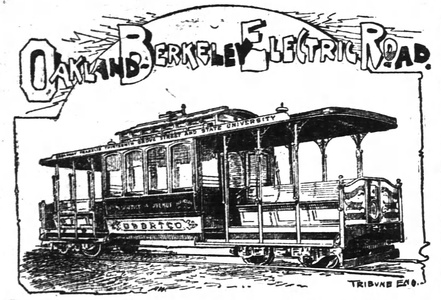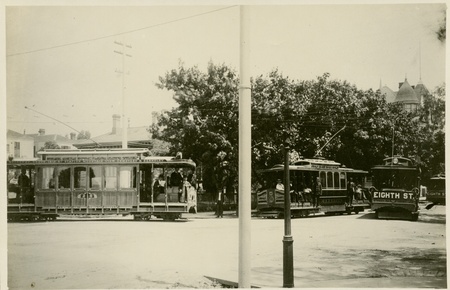The Oakland Consolidated Street Railway (OCSR) was the first electric streetcar railway in Oakland. It started with the Oakland and Berkeley Rapid Transit Company (O&BRT) with a line up Grove Street (now MLK) to Berkeley which started service on May 12, 1891. The OCSR was started a bit later by many of the same investors, then purchased the O&BRT; the latter formally became the Oakland Consolidated Street Railway on November 1, 1891. 20
A few years after that in 1893, it was acquired by "Borax" Smith. In 1898, the Oakland Transit Company filed for incorporation, which included the OCSR, the Central Avenue Railway Company, and the Alameda, Oakland, and Piedmont Electric Railway Company. It would eventually all become part of the Key System. 21,26
Oakland and Berkeley Rapid Transit Company
In July 1889, Francis Kittredge Shattuck, A.J. Synder, A.T. Eastland, J.W. Coleman, John E. McElrath, James Gamble, Volney D. Moody, George W. McNear, James McGee, Louis Gottshall and A.F. Poirer met and decided to incorporate a company to run an electric streetcar up to Berkeley. The officers of the company were to be Shattuck - president; McNear - vice president; Leland Gamble - secretary; Moody - treasurer. The Oakland Gas, Light, and Heat Company offered to supply the electricity. The line was to be 5 miles long, and was projected to cost $25,000 per mile. There was no mention of a stock offering, but the Tribune noted that the directors alone could afford to build it. 1
Before construction could begin, the company needed a franchise from the city. A draft ordinance was put forth with amendments from the council. Council member Towle wanted an amendment moving the southern terminus from 2nd Street and Broadway to 1st Street and Franklin, but McElrath pointed out that such an amendment would invalidate the ordinance and require the bid process start all over again. The ordinance without Towle's amendment was passed to print. 2 There was more council discussion of the proposed line. Council member Evans had compiled his own report, and was against the use of electricity. The electricity would damage the watches of passengers. "The electricity leaking passes into the cars and into the bodies of the passengers." Council member Hackett replied "It is very unfortunate for this city that some people don't learn anything. There is not a boy or man in this city except one or two men in this council that is not aware that electric railroads have proved successful." The ordinance was passed, with Evans voting no. 3
But more difficulties were ahead. Mayor Glascock vetoed the ordinance. The first points regarding the maximum fare and the height of the poles holding up the wires could be readily addressed, but his third point was that although the city charter permitted it, state law prohibited the use of anything but horses, mules, or underground cables for propelling streetcars. 4 The company indicated they planned to go ahead despite the mayor's veto. 5 In November 1889, the council voted to override the mayor's veto, and have the courts settle the matter. Even Evans voted for it, because he wanted to test the validity of the city charter. 6 Despite the ruling in the Ah You case, the stockholders decided to go ahead and begin work on the line. 7
In March 1891, the company reorganized to reduce the number of directors from 11 to 5, and elect new officers: George McNear - president; John McElrath - vice president; H.S. Hunt - secretary. Shattuck had sold his stock to William H. Martin, former secretary Leland Gamble had disappeared along with approximately $1,200 and a stock certificate, 9,10 and James Gamble didn't have sufficient ready capital to continue. 8
They had sufficient time to build their own powerhouse at Temescal, with 4 boilers and space for 4 more if needed. There was also a car barn across 47th from the powerhouse. Eight double-end cars were built by the Stockton Combined Harvester and Agricultural Works, and the Stockton Wheel Company was building 4 enclosed cars. 8
The tracks and wires were completed at the end of March, but the cars weren't ready. 11 Finally, after a few hitches (including the flanges on the wheels being too large), 12 on May 12, 1891, the line was operational. 8
 1891 8
1891 8 at Temescal, 1903 Sanborn excerpt
at Temescal, 1903 Sanborn excerpt former car barn at 4629 MLK
former car barn at 4629 MLK
They had been in operation for a only a few weeks when they hit their first major problems. On June 1, 1891 the Tribune reported that the motors were burning out. New, more powerful motors were ordered from the Edison company, but it might take up to a month to get them. But the next day they reported that the motors were not burning out, but there was a mechanical problem with the design. The motors were being reworked at Judson, and they hoped to have the cars back in operation by the end of the week. It took a bit longer, but the SF Call reported on June 16 that the cars were running again. 13,14,15 New, more powerful motors were on order, though, and expected to reduce the end-to-end travel time from 30-35 minutes to 25 minutes. 16
The O&BRT was deeded to the Oakland Consolidated Street Railway in August 1891, but there were still frequent references to the O&BRT in the newspapers after that as the name didn't take effect until November. At the end of August, the O&BRT petition to the county supervisors to run a new line from 40th and Grove to Webster (present day Piedmont Avenue) and then up to the gates of Mountain View Cemetery. 19
Oakland Consolidated Street Railway Company
Even before the O&BRT was complete, the same group met in October 1890 to incorporate the Oakland Consolidated Street Railway Company (OCSR), which would have lines going as far east as Fruitvale Avenue, and also connect to the O&BRT. It had $1,000,000 stock in 20,000 shares. It was noted that the O&BRT would probably be transferred to the new company. 17
Once the O&BRT was running, in July 1891 it was announced that the Oakland Consolidated was going to buy the O&BRT. The same article noted the OCSR was waiting on rails to begin construction of their east-west line. 18 The name was formally changed on November 1, 1891. 20
During 1892, the OCSR applied to build various extensions, including one down Washington, and another to Piedmont. The bigger news was that R.C. Beggs, the secretary of the OCSR, had absconded with thousands of dollars, along with a man named Gallagher. 25 The men were caught north of Redding.
In April 1893, it was announced that "Borax" Smith had acquired the OCSR including the route to Berkeley. By this time, they had also added the branch to Mountain View Cemetery, and a branch to the 16th Street Station via Grove and 8th Streets. 21
 1893 map showing various railways 22
1893 map showing various railways 22
Link and References
- The Nucleus of a Great Electric System Formed Oakland Tribune July 19, 1889
- Votes Upon Business of the City Council Oakland Tribune September 17, 1889
- A Franchise Matter Oakland Times October 4, 1889
- The Veto Oakland Tribune October 12, 1889
- Effect of Mayor's Veto on the Electric Franchise Oakland Tribune November 16, 1889
- A Vain Veto Oakland Tribune November 19, 1889
- To Be Built Oakland Tribune February 4, 1890
- Oakland Berkeley Electric Road Oakland Tribune May 12, 1891
- Lee Gamble's Gone Oakland Tribune August 16, 1890
- Gamble's Shortage Oakland Tribune August 21, 1890
- The Last Rail Laid Oakland Tribune March 25, 1891
- A Hitch in the Trial Trip of the Rapid Transit Company San Francisco Examiner May 1, 1891
- Electric Cars Stop Oakland Tribune June 1, 1891
- The Cars Will Run Again Oakland Tribune June 2, 1891
- They Are Running Once More San Francisco Call June 16, 1891
- The Time to Berkeley Oakland Tribune June 23, 1891
- Incorporation of Another Street Railway Company San Francisco Call October 11, 1890
- Rails Wanted Oakland Tribune July 30, 1891
- Another Branch San Francisco Chronicle August 28, 1891
- A New Name Oakland Tribune October 24, 1891
- Smith Goes Ahead in Style Oakland Tribune April 25, 1893
- Everywhere For A Nickel Oakland Enquirer July 3, 1893
- William Gardiner transportation collection 1869-1951, Stanford Libraries
- Electric Road Wants to Make an Extension Oakland Tribune May 27, 1892
- R.C. Beggs Is Missing Oakland Tribune June 7, 1892
- Realty Lines Now Under One Management Oakland Tribune March 22, 1898
- In Grandpa's Day... The Western Railroader February 1959 (includes more photos)
- Oakland Consolidated Street Railway Street Railway Journal July 1893





